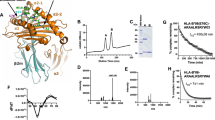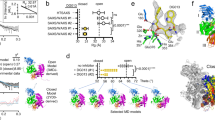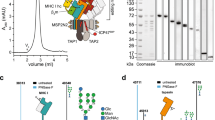Abstract
ERAP1 trims antigen precursors to fit into MHC class I proteins. To fulfill this function, ERAP1 has unique substrate preferences, trimming long peptides but sparing shorter ones. To identify the structural basis for ERAP1's unusual properties, we determined the X-ray crystal structure of human ERAP1 bound to bestatin. The structure reveals an open conformation with a large interior compartment. An extended groove originating from the enzyme's catalytic center can accommodate long peptides and has features that explain ERAP1's broad specificity for antigenic peptide precursors. Structural and biochemical analyses suggest a mechanism for ERAP1's length-dependent trimming activity, whereby binding of long rather than short substrates induces a conformational change with reorientation of a key catalytic residue toward the active site. ERAP1's unique structural elements suggest how a generic aminopeptidase structure has been adapted for the specialized function of trimming antigenic precursors.
This is a preview of subscription content, access via your institution
Access options
Subscribe to this journal
Receive 12 print issues and online access
$189.00 per year
only $15.75 per issue
Buy this article
- Purchase on Springer Link
- Instant access to full article PDF
Prices may be subject to local taxes which are calculated during checkout








Similar content being viewed by others
Change history
24 April 2011
In the version of this article initially published online, nucleotide should have read peptide in a number of places. The error has been corrected for all versions of this article.
References
Rock, K.L., York, I.A. & Goldberg, A.L. Post-proteasomal antigen processing for major histocompatibility complex class I presentation. Nat. Immunol. 5, 670–677 (2004).
Fruci, D., Niedermann, G., Butler, R.H. & van Endert, P.M. Efficient MHC class I-independent amino-terminal trimming of epitope precursor peptides in the endoplasmic reticulum. Immunity 15, 467–476 (2001).
Serwold, T., Gaw, S. & Shastri, N. ER aminopeptidases generate a unique pool of peptides for MHC class I molecules. Nat. Immunol. 2, 644–651 (2001).
Saric, T. et al. An IFN-gamma-induced aminopeptidase in the ER, ERAP1, trims precursors to MHC class I-presented peptides. Nat. Immunol. 3, 1169–1176 (2002).
Serwold, T., Gonzalez, F., Kim, J., Jacob, R. & Shastri, N. ERAAP customizes peptides for MHC class I molecules in the endoplasmic reticulum. Nature 419, 480–483 (2002).
York, I.A. et al. The ER aminopeptidase ERAP1 enhances or limits antigen presentation by trimming epitopes to 8–9 residues. Nat. Immunol. 3, 1177–1184 (2002).
Blanchard, N. et al. Endoplasmic reticulum aminopeptidase associated with antigen processing defines the composition and structure of MHC class I peptide repertoire in normal and virus-infected cells. J. Immunol. 184, 3033–3042 (2010).
York, I.A., Brehm, M.A., Zendzian, S., Towne, C.F. & Rock, K.L. Endoplasmic reticulum aminopeptidase 1 (ERAP1) trims MHC class I-presented peptides in vivo and plays an important role in immunodominance. Proc. Natl. Acad. Sci. USA 103, 9202–9207 (2006).
Yan, J. et al. In vivo role of ER-associated peptidase activity in tailoring peptides for presentation by MHC class Ia and class Ib molecules. J. Exp. Med. 203, 647–659 (2006).
Firat, E. et al. The role of endoplasmic reticulum-associated aminopeptidase 1 in immunity to infection and in cross-presentation. J. Immunol. 178, 2241–2248 (2007).
Blanchard, N. et al. Immunodominant, protective response to the parasite Toxoplasma gondii requires antigen processing in the endoplasmic reticulum. Nat. Immunol. 9, 937–944 (2008).
Brown, M.A. Genetics of ankylosing spondylitis. Curr. Opin. Rheumatol. 22, 126–132 (2010).
Fung, E.Y. et al. Analysis of 17 autoimmune disease-associated variants in type 1 diabetes identifies 6q23/TNFAIP3 as a susceptibility locus. Genes Immun. 10, 188–191 (2009).
Mehta, A.M. et al. Single nucleotide polymorphisms in antigen processing machinery component ERAP1 significantly associate with clinical outcome in cervical carcinoma. Genes Chromosom. Cancer 48, 410–418 (2009).
Yamamoto, N. et al. Identification of 33 polymorphisms in the adipocyte-derived leucine aminopeptidase (ALAP) gene and possible association with hypertension. Hum. Mutat. 19, 251–257 (2002).
Chang, S.C., Momburg, F., Bhutani, N. & Goldberg, A.L. The ER aminopeptidase, ERAP1, trims precursors to lengths of MHC class I peptides by a 'molecular ruler' mechanism. Proc. Natl. Acad. Sci. USA 102, 17107–17112 (2005).
Kisselev, A.F., Akopian, T.N., Woo, K.M. & Goldberg, A.L. The sizes of peptides generated from protein by mammalian 26 and 20 S proteasomes. Implications for understanding the degradative mechanism and antigen presentation. J. Biol. Chem. 274, 3363–3371 (1999).
Momburg, F., Roelse, J., Hammerling, G.J. & Neefjes, J.J. Peptide size selection by the major histocompatibility complex-encoded peptide transporter. J. Exp. Med. 179, 1613–1623 (1994).
Schumacher, T.N. et al. Peptide length and sequence specificity of the mouse TAP1/TAP2 translocator. J. Exp. Med. 179, 533–540 (1994).
van Endert, P.M. et al. A sequential model for peptide binding and transport by the transporters associated with antigen processing. Immunity 1, 491–500 (1994).
Kanaseki, T., Blanchard, N., Hammer, G.E., Gonzalez, F. & Shastri, N. ERAAP synergizes with MHC class I molecules to make the final cut in the antigenic peptide precursors in the endoplasmic reticulum. Immunity 25, 795–806 (2006).
Falk, K., Rotzschke, O. & Rammensee, H.G. Cellular peptide composition governed by major histocompatibility complex class I molecules. Nature 348, 248–251 (1990).
Infantes, S. et al. H-2Ld class I molecule protects an HIV N-extended epitope from in vitro trimming by endoplasmic reticulum aminopeptidase associated with antigen processing. J. Immunol. 184, 3351–3355 (2010).
Hattori, A., Matsumoto, H., Mizutani, S. & Tsujimoto, M. Molecular cloning of adipocyte-derived leucine aminopeptidase highly related to placental leucine aminopeptidase/oxytocinase. J. Biochem. 125, 931–938 (1999).
Evnouchidou, I. et al. The internal sequence of the peptide-substrate determines its N-terminus trimming by ERAP1. PLoS ONE 3, e3658 (2008).
Hearn, A., York, I.A. & Rock, K.L. The specificity of trimming of MHC class I-presented peptides in the endoplasmic reticulum. J. Immunol. 183, 5526–5536 (2009).
Saveanu, L. et al. Concerted peptide trimming by human ERAP1 and ERAP2 aminopeptidase complexes in the endoplasmic reticulum. Nat. Immunol. 6, 689–697 (2005).
Rawlings, N.D., Barrett, A.J. & Bateman, A. MEROPS: the peptidase database. Nucleic Acids Res. 38, D227–D233 (2010).
Andrade, M.A., Petosa, C., O'Donoghue, S.I., Muller, C.W. & Bork, P. Comparison of ARM and HEAT protein repeats. J. Mol. Biol. 309, 1–18 (2001).
Suhre, K. & Sanejouand, Y.H. ElNemo: a normal mode web server for protein movement analysis and the generation of templates for molecular replacement. Nucleic Acids Res. 32, W610–W614 (2004).
Thompson, M.W., Archer, E.D., Romer, C.E. & Seipelt, R.L. A conserved tyrosine residue of Saccharomyces cerevisiae leukotriene A4 hydrolase stabilizes the transition state of the peptidase activity. Peptides 27, 1701–1709 (2006).
Addlagatta, A., Gay, L. & Matthews, B.W. Structure of aminopeptidase N from Escherichia coli suggests a compartmentalized, gated active site. Proc. Natl. Acad. Sci. USA 103, 13339–13344 (2006).
Thunnissen, M.M., Nordlund, P. & Haeggstrom, J.Z. Crystal structure of human leukotriene A(4) hydrolase, a bifunctional enzyme in inflammation. Nat. Struct. Biol. 8, 131–135 (2001).
Ito, K. et al. Crystal structure and mechanism of tripeptidyl activity of prolyl tripeptidyl aminopeptidase from Porphyromonas gingivalis. J. Mol. Biol. 362, 228–240 (2006).
Tholander, F. et al. Structure-based dissection of the active site chemistry of leukotriene A4 hydrolase: implications for M1 aminopeptidases and inhibitor design. Chem. Biol. 15, 920–929 (2008).
Fournié-Zaluski, M.C. et al. Structure of aminopeptidase N from Escherichia coli complexed with the transition-state analogue aminophosphinic inhibitor PL250. Acta Crystallogr. D Biol. Crystallogr. 65, 814–822 (2009).
Tsujimoto, M. & Hattori, A. The oxytocinase subfamily of M1 aminopeptidases. Biochim. Biophys. Acta 1751, 9–18 (2005).
Tanioka, T. et al. Human leukocyte-derived arginine aminopeptidase. The third member of the oxytocinase subfamily of aminopeptidases. J. Biol. Chem. 278, 32275–32283 (2003).
Goto, Y., Tanji, H., Hattori, A. & Tsujimoto, M. Glutamine-181 is crucial in the enzymatic activity and substrate specificity of human endoplasmic-reticulum aminopeptidase-1. Biochem. J. 416, 109–116 (2008).
Monecke, T. et al. Crystal structure of the nuclear export receptor CRM1 in complex with Snurportin1 and RanGTP. Science 324, 1087–1091 (2009).
Kochan, G. et al. Crystal structures of the endoplasmic reticulum aminopeptidase-1 ERAP1 reveal the molecular basis of N-terminal peptide trimming. Proc. Natl. Acad. Sci. USA (in the press).
Evnouchidou, I., Berardi, M.J. & Stratikos, E. A continuous fluorigenic assay for the measurement of the activity of endoplasmic reticulum aminopeptidase 1: competition kinetics as a tool for enzyme specificity investigation. Anal. Biochem. 395, 33–40 (2009).
Segel, I. Enzyme Kinetics: Behavior and Analysis of Rapid Equilibrium and Steady-State Enzyme Systems 984 (Wiley, New York, 1993).
Moussaoui, M., Guasch, A., Boix, E., Cuchillo, C. & Nogues, M. The role of non-catalytic binding subsites in the endonuclease activity of bovine pancreatic ribonuclease A. J. Biol. Chem. 271, 4687–4692 (1996).
Birrell, G.B., Zaikova, T.O., Rukavishnikov, A.V., Keana, J.F. & Griffith, O.H. Allosteric interactions within subsites of a monomeric enzyme: kinetics of fluorogenic substrates of PI-specific phospholipase C. Biophys. J. 84, 3264–3275 (2003).
Kyrieleis, O.J., Goettig, P., Kiefersauer, R., Huber, R. & Brandstetter, H. Crystal structures of the tricorn interacting factor F3 from Thermoplasma acidophilum, a zinc aminopeptidase in three different conformations. J. Mol. Biol. 349, 787–800 (2005).
Towler, P. et al. ACE2 X-ray structures reveal a large hinge-bending motion important for inhibitor binding and catalysis. J. Biol. Chem. 279, 17996–18007 (2004).
Comellas-Bigler, M., Lang, R., Bode, W. & Maskos, K. Crystal structure of the E. coli dipeptidyl carboxypeptidase Dcp: further indication of a ligand-dependent hinge movement mechanism. J. Mol. Biol. 349, 99–112 (2005).
Holland, D.R. et al. Structural comparison suggests that thermolysin and related neutral proteases undergo hinge-bending motion during catalysis. Biochemistry 31, 11310–11316 (1992).
Grams, F. et al. Structure of astacin with a transition-state analogue inhibitor. Nat. Struct. Biol. 3, 671–675 (1996).
Matsuura, Y. & Stewart, M. Structural basis for the assembly of a nuclear export complex. Nature 432, 872–877 (2004).
Shen, Y., Joachimiak, A., Rosner, M.R. & Tang, W.J. Structures of human insulin-degrading enzyme reveal a new substrate recognition mechanism. Nature 443, 870–874 (2006).
Malito, E. et al. Molecular bases for the recognition of short peptide substrates and cysteine-directed modifications of human insulin-degrading enzyme. Biochemistry 47, 12822–12834 (2008).
Georgiadou, D. et al. Placental leucine aminopeptidase efficiently generates mature antigenic peptides in vitro but in patterns distinct from endoplasmic reticulum aminopeptidase 1. J. Immunol. 185, 1584–1592 (2010).
Burton, P.R. et al. Association scan of 14,500 nonsynonymous SNPs in four diseases identifies autoimmunity variants. Nat. Genet. 39, 1329–1337 (2007).
Harvey, D. et al. Investigating the genetic association between ERAP1 and ankylosing spondylitis. Hum. Mol. Genet. 18, 4204–4212 (2009).
Otwinowski, Z. & Minor, W. Processing of X-ray diffraction data collected in oscillation mode. Methods Enzymol. 276, 307–326 (1997).
McCoy, A.J. et al. Phaser crystallographic software. J. Appl. Crystallogr. 40, 658–674 (2007).
Terwilliger, T.C. Maximum-likelihood density modification. Acta Crystallogr. D Biol. Crystallogr. 56, 965–972 (2000).
Adams, P.D. et al. PHENIX: a comprehensive Python-based system for macromolecular structure solution. Acta Crystallogr. D Biol. Crystallogr. 66, 213–221 (2010).
Acknowledgements
We thank E. Livaniou and P. Klimentzou (National Centre for Scientific Research 'Demokritos') for assistance with chemical synthesis of the LMe peptide, L. Lee for cell culture, L. Lu for assistance with baculovirus, protein expression and purification, D. Panne, Z. Zavala-Ruiz and E. Schreiter for help with cryocrystallography, and H. Robinson, A. Heroux and V. Stojanoff for assistance with data collection. Data for this study were measured at beamlines X6, X25 and X29 of the National Synchrotron Light Source. These beamlines are supported by the Offices of Biological and Environmental Research and of Basic Energy Sciences of the US Department of Energy, and by the National Center for Research Resources of the National Institutes of Health. Resources of the University of Massachusetts Medical School Mass Spectrometry Facility and Diabetes and Endocrine Research Center were used. Funding for this work was provided by the Sixth Framework Programme of the European Union (Marie Curie International Reintegration grant 017157 to E.S.) and the National Institutes of Health grants AI-38996 (L.J.S.). I.E. acknowledges financial support from NCSR Demokritos graduate fellowship program. L.J.S. and K.L.R. are members of the University of Massachusetts Diabetes and Endocrinology Research Center (DK32520).
Author information
Authors and Affiliations
Contributions
T.T.N. determined the crystal structure, designed and conducted enzymatic studies, interpreted results and helped write the paper, S.-C.C. expressed ERAP1 in insect cells and designed and conducted peptide trimming and allosteric activation experiments, I.E. designed and conducted peptide trimming and allosteric activation and inhibition experiments and interpreted results, I.A.Y. interpreted data and helped write the paper, C.Z. synthesized the LMe peptide, K.L.R. and A.L.G. designed experiments, interpreted data and helped write the paper, and E.S. and L.J.S. designed and conducted experiments, interpreted data and helped write the paper.
Corresponding author
Ethics declarations
Competing interests
The authors declare no competing financial interests.
Supplementary information
Supplementary Text and Figures
Supplementary Figures 1–4 and Supplementary Tables 1 and 2 (PDF 9320 kb)
Supplementary Movie 1
Normal mode analysis (MOV 2244 kb)
Rights and permissions
About this article
Cite this article
Nguyen, T., Chang, SC., Evnouchidou, I. et al. Structural basis for antigenic peptide precursor processing by the endoplasmic reticulum aminopeptidase ERAP1. Nat Struct Mol Biol 18, 604–613 (2011). https://doi.org/10.1038/nsmb.2021
Received:
Accepted:
Published:
Issue Date:
DOI: https://doi.org/10.1038/nsmb.2021
This article is cited by
-
Conformational remodeling enhances activity of lanthipeptide zinc-metallopeptidases
Nature Chemical Biology (2022)
-
The ERAP1 active site cannot productively access the N-terminus of antigenic peptide precursors stably bound onto MHC class I
Scientific Reports (2021)
-
Conformational dynamics linked to domain closure and substrate binding explain the ERAP1 allosteric regulation mechanism
Nature Communications (2021)
-
Genetic association of ERAP1 and ERAP2 with eclampsia and preeclampsia in northeastern Brazilian women
Scientific Reports (2021)
-
Polymorphisms in endoplasmic reticulum aminopeptidase genes are associated with cervical cancer risk in a Chinese Han population
BMC Cancer (2020)



